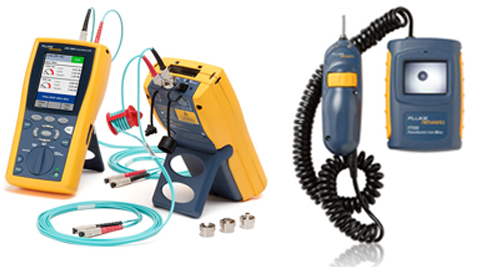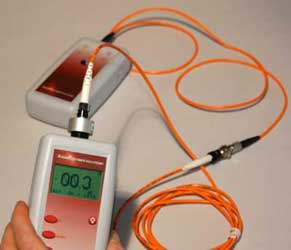OFDA Systems for Enhancing Fibre Analysis in Manufacturing Processes
OFDA Systems for Enhancing Fibre Analysis in Manufacturing Processes
Blog Article
Essential Features to Search For in Optical Fibre Screening Tools
When reviewing optical fiber testing devices, a number of necessary attributes necessitate careful consideration to ensure optimum performance and reliability. Trick features such as precision, precision, and user-friendly interfaces play a crucial role in effective dimension and convenience of usage. The importance of portability and resilience can not be overemphasized, particularly for on-site applications. Compatibility with existing industry standards boosts performance, while advanced measurement capabilities, consisting of TDR and OTDR screening, deal crucial understandings into network honesty. Recognizing these features will certainly clarify just how to select the ideal equipment for your certain requirements. What variables might you prioritize?
Precision and Precision
Accuracy and accuracy are crucial criteria in the evaluation of optical fibre screening tools. These 2 qualities make sure that dimensions reflect real efficiency of fiber optic systems, which is vital for efficient network setup, maintenance, and troubleshooting. Precision refers to the nearness of a gauged value to the actual worth, while precision denotes the repeatability of measurements under the same conditions.
When choosing optical fibre screening tools, it is necessary to consider instruments that offer high precision and accuracy to lessen mistakes in information analysis. Tools such as optical time-domain reflectometers (OTDRs) and power meters need to have calibration devices to make sure regular efficiency with time. In addition, the requirements given by manufacturers must information the equipment's dimension uncertainty, which directly impacts the reliability of test results.
Additionally, the performance of optical fiber testing tools can be affected by ecological factors, such as temperature level and humidity. Therefore, picking equipment developed to alleviate these variables will certainly boost dimension fidelity. In verdict, buying optical fibre testing tools with robust accuracy and accuracy functions is basic for keeping optimum network performance and ensuring the integrity of fiber optic interactions.

User-Friendly Interface
The performance of optical fibre screening equipment is not only identified by its precision and precision; an easy to use user interface plays a significant duty in enhancing functional effectiveness. A well-designed user interface simplifies the interaction in between the professional and the tools, enabling an extra intuitive understanding of intricate functions.
Secret attributes of an user-friendly interface consist of clear navigation food selections, sensible layouts, and quickly available controls. These components enable specialists to do examinations swiftly without comprehensive training, minimizing the likelihood of user mistake - ofda. Moreover, aesthetic indicators such as progress bars, informs, and visual depictions of information can dramatically enhance the user experience by providing immediate feedback on the screening procedure.
In addition, personalized setups can better enhance procedures by allowing users to readjust criteria according to certain screening demands. This flexibility not just conserves time however also guarantees that the equipment meets diverse application requirements.
Integrating help functions, such as tooltips and extensive guidebooks, right into the interface can better empower individuals, promoting self-sufficiency and self-confidence in operating the equipment. Inevitably, an user-friendly user interface is essential for making best use of the capacity of optical fiber screening equipment, causing more efficient and reliable testing end results.
Mobility and Durability
Mobility and toughness are critical characteristics of optical fibre testing devices, making certain that it can endure the roughness of numerous atmospheres while continuing to be simple to transportation. Service technicians typically work in varied settings, from telecoms hubs to remote setups, making it important that screening tools are lightweight and small (ofda). Devices developed with transportability in mind usually includes ergonomic handles and situations that promote effortless movement, thus improving operational effectiveness on-site
Toughness is similarly necessary, as optical fiber testing devices is typically subjected to harsh conditions, including temperature level fluctuations, dampness, and physical impacts. Devices constructed with rugged materials such as enhanced plastics or steel real estates are much better fit for these environments, minimizing the risk of damage throughout usage and transport. Additionally, devices with water and dust resistance rankings, such as IP scores, guarantees reputable efficiency in difficult conditions.
Compatibility With Standards
Making certain compatibility with sector criteria is important for optical fibre screening devices, as it straight affects the reliability and legitimacy of test outcomes. Optical fibre networks are subject to rigorous performance standards developed by various companies, consisting of the Telecommunications Sector Association (TIA) and the International Electrotechnical Commission (IEC) Testing devices must comply with these standards to make certain that measurements are regular and comparable throughout different systems and settings.
When choosing optical fiber testing tools, users must verify that the gadget meets appropriate criteria essential to their particular application, such as those relevant to attenuation, data transfer, and crosstalk. Tools that is compliant with established requirements not just assists in attaining precise outcomes but also helps with interoperability amongst devices from various manufacturers.
Furthermore, compatibility with standards guarantees that the tools can be used in governing conformity circumstances, which is vital for tasks in industries such as telecoms, aerospace, and army applications. For that reason, buying optical fiber screening equipment that aligns with present market criteria is a fundamental facet of maintaining high quality assurance and attaining optimal network performance.
Advanced Dimension Capabilities
Advanced measurement capacities are a specifying attribute of modern-day optical fiber testing devices, enabling comprehensive analysis of network performance. These capabilities guarantee that specialists can assess vital parameters such as signal loss, dispersion, and bandwidth, which are essential for preserving ideal interaction effectiveness.
One secret aspect is the capability to conduct time-domain reflectometry (TDR) and optical time-domain reflectometry (OTDR) tests. These techniques enable users to recognize mistakes, measure the length of fibres, and establish the area of issues with website link impressive accuracy - ofda. Moreover, innovative equipment usually consists of the ability to measure optical power degrees, helping to assess the general health of the network and make certain conformity with the required requirements.
Furthermore, some testing gadgets visit the site offer sophisticated formulas for real-time analysis, making it possible for quicker diagnosis and troubleshooting. This is specifically important in high-speed networks where downtime can cause significant monetary losses. With the assimilation of advanced software program interfaces, individuals can envision data better, assisting in informed decision-making. Finally, buying optical fibre testing devices with innovative dimension capabilities is crucial for making sure network dependability and efficiency in today's requiring telecoms landscape.
Conclusion

Report this page